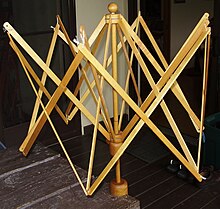Thread winch


A yarn winch is a technical aid that is used when unwinding and rewinding and unwinding yarn in strand form .
General
In contrast to the function of a reel whose scope is laid down and the on wrap of yarn used has a yarn is wound in its scope be variable to be able to accommodate strands of different lengths. Yarn winches are used in hand and home weaving and in knitting to fill bobbins or produce balls.
In order to be able to lay a strand on the yarn winch at all, it is necessary to push its individual parts together in some way and then to pull out and fix them to the required extent.
Various forms are used for this, which confusingly are referred to as "reel" in normal parlance:
Umbrella reel
A shape similar to an umbrella , which is used especially for household use in knitting and hand spinning . An umbrella reel is usually screwed to a table and runs horizontally.
Roller reel
Reels are a stand-alone form on the floor that consists of two wooden, rotatable cylinders with a diameter of 10 to 20 cm. Both roles can be moved and fixed independently of one another on a vertical support. The yarn runs off vertically here. Reels are mainly used in hand weaving . They are the most variable in terms of the length of the strands that can be used and run the most smoothly.
Further
- A different form of a yarn winch consists of four pyramid-shaped diverging strips that are firmly mounted around a rotating central axis. This allows strands of different lengths to be simply placed from above. The drainage takes place horizontally.
- A cross made of two strips on a free-standing base is very old. The vertical bars can be inserted into various drill holes on the strips.
- A more complicated construction is the so-called carbolzer, which consists of at least two, often three ladder- like components that can be folded into one another and run vertically. The rotating part of the device can be lifted out of the underframe, folded up to place the string, then pushed apart and locked. The circumference is regulated by removable bars.
history
Yarn winches were introduced from the Orient in the 13th century together with the free-standing loom , the winding wheel and the spinning wheel, as well as other weaving accessories. A simple form of a thread winch is e.g. B. already depicted around 1310 in Le Livre des Métiers d'Ypres .
Individual evidence
- ^ Wilhelm Bomann: Rural housekeeping and daily work in old Lower Saxony . 6. reprograph. Reprint d. 4th edition from 1941, Hildesheim 1983 ( ISBN 3-8067-0546-1 ), pp. 250-252
- ↑ Eric Broudy: The book of the looms. A history of the Handlom from ancient times to the present. Hanover (New England) 1979 ( ISBN 0-87451-649-8 ), p. 142

